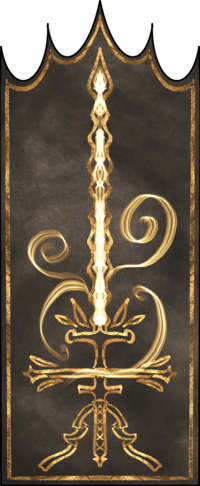More actions
Sangria, Blessed Blade of the Glory-Seeker, is one of the many weapons of Emperor Allestrain I of Regalia, a legendary large longsword. Sangria was one of Emperor Allest's most remarkable weapons, on account of its size and design, and in many ways became tied to his reputation as an undefeated champion both on the battlefield and in the arena. Sangria is considered one of Unionism's weapons, as it led the charge against the Pagan armies of the Skaggers while Allest made war with them. It was the Skaggers eventually who defeated and killed Emperor Allest, after which the weapon was used as a trophy among them. Eventually, the weapon disappeared from the historical narration, until it reappeared in Regalia, either by divine hands or because the weapon was rumored always to seek the worthy to wield it for the faith.
| Sangria, Blessed Blade of the Glory-Seeker | |
|---|---|
 | |
| Artifacts | |
| Name | Sangria, Blessed Blade of the Glory-Seeker |
| Origin | Emperor Allestrain I |
| Type | Weapon |
Description
Sangria is classified as a Weapon Artifact, meaning it cannot be wielded at the same time with other Weapon Artifacts by the same owner. Sangria is a longsword in design, though because Allest was large and the weapon was made to fit his proportions, it is sometimes thought of as a greatsword in the hands of an average or short person. The weapon has a strongly reflective opalescent sheen, Unionist iconography, and sacred prayer linens wrapped around the handle that would traditionally be used to embalm the dead before cremation.
Artifact Mechanics
Artifact Mechanics are split between Permanent Mechanics, Sparked Mechanics and Sparked Combat Mechanics. Permanent Mechanics are always available to the wielder of the Artifact. Sparked Mechanics and Sparked Combat Mechanics are only available if the Artifact has an Artifactspark. Sparked Combat Mechanics are noted separately, because this makes them easier to find, but they are no different from Sparked Mechanics in general. For more information on Artifactsparks, read the Resources Page. For Rules on Artifact ownership, see the Artifacts Page.
Permanent Mechanics
- Sangria allows its wielder to use a Deity-Form Transformation, which transforms their body into that of a divine God-like superhuman warrior in appearance, larger, stronger, and faster, clad in classical gladiatorial armor as a champion of the Gods. This change counts as a Transformation but does not count as a Disguise (which is pointless anyway due to Artifact ownership rules). Also while using this Transformation during Divinium summoning, Unionist Gods will treat the wielder as one of them which unlocks additional dialogue options.
Sparked Mechanics
- Sangria's wielder can choose 3 Free Packs from the following Categories: Paladin Point Buy, Melee Point Buy, or Training Point Buy.
- Sangria allows its wielder to summon Firebrand, a God-like avatar of the Unionist god Brand onto the battlefield during Calendar-planned Combat Scenarios, like Temple Raids, Aelrrigan Vault Raids, or Clandestine Base Raids. Firebrand will be portrayed by a Staff member and fights with the power of two Characters with their own set of Abilities. Firebrand will fight until reduced to 0 HP, or until Sangria's wielder reaches 0 HP. Firebrand also does not take a participant slot.
- Sangria grants the wielder access to Allest's Sanctuary, a pocket dimension (instance Region) castle in the City of Regalia (Contact Staff to move it). They can also let others in (willingly), no one else can break in without permission. While within the Sanctuary, they can suspend (not remove, just pause) the effects of any player-applied Curses, including Custom Kit Prized Curses. Curse effects immediately re-activate as soon as the individual exits the Sanctuary.
- Sangria as a weapon was used to make war, and hunt down non-believers who refused the authority of the Regalian Empire. Sangria grants the wielder +2 Attack Stat (breaking Cap up to 11) while using Attack Emotes on those of the following Religions: Fornoss, Minor Faiths, Evolism. Additionally, even when not attacking Characters of these faiths, the wielder's Attack Dice Roll Minimum is set to 3.
Collectible Artifact
Artifacts are very cool, and make a Character super powerful. That being said, due to circumstances of Roleplay, a Character may end up holding onto an Artifact for months on end. This is generally not a problem, but we believe that Artifacts because of their uniqueness, should never be held onto in perpetuity by one Player. After a few months, it is time for the next player to be able to enjoy the artifact, and for this reason, Collectibles exist. After 120 days of non-consecutive Artifact ownership, an Artifact is automatically confiscated, and the Player who lost it is given a Collectible. Collectibles are thematically and aesthetically similar to the Artifact, meaning the loss of an Artifact does not visually detract from a Character's established design. However, they cannot hold Artifactsparks and only inherit the Permanent Mechanics from the Artifact they were generated from (including the rules limiting their use). On the other hand, Collectibles can never be stolen from their owner, a Collectible is owned forever, and there is no upper limit to the amount of Collectibles a Character can have, or wield/use at the same time. Collectibles cannot be traded in, though some Events may ask for their sacrifice, destroying the Collectible. To summarize this Artifact's Collectible properties:
- When this Artifact is exchanged for a Collectible, the Artifact seeks new piety for its cause, leaving behind a Sanctus Blade.
- The Sanctus Blade Collectible inherits the Permanent Mechanic of the Artifact.
- While there are several Sanctus Blades, each looks unique, though should be inspired by the Artifact.
| Accreditation | |||||||||
|---|---|---|---|---|---|---|---|---|---|
|
| ||||||||